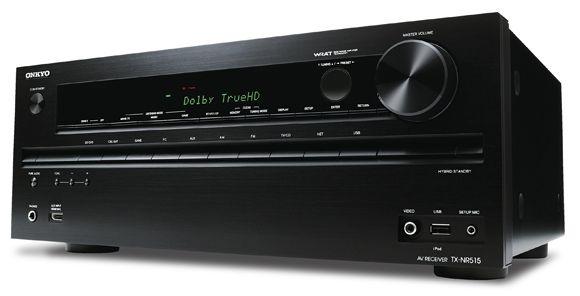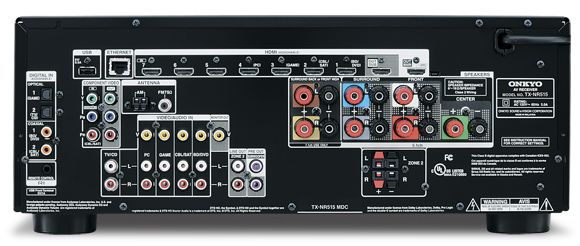Onkyo TX-NR515 review

When it comes to AV receivers, Onkyo campaigns to be the people’s champion. Every year its entry-level models come packed to the hilt with features, sporting a competitive price tag and, more often than not, a nailed-on sound quality, too. This commitment to value has made Onkyo the best-selling home cinema receiver brand for four years running, which kinda tells you everything you need to know.
And with the TX-NR515, the second-best specced model in its current cluster of entry-level AV receivers, Onkyo looks to be continuing down the same path. For £500 it offers most of the latest mod cons, including network functionality with Spotify, web radio and DLNA streaming, 3D-passthrough and Dolby Pro Logic IIz. It’s also ‘futureproofed’ for the next generation of hi-def TVs, courtesy of Marvell’s 4K-upscaling QDEO technology.
This 7.2-channel affair replaces the TX-NR579. Onkyo says it kicks out 130W-per-channel, although this is quoted into 6 Ohms, with just a single channel driven. As usual with affordable AVRs, you can assume a more realistic five- or seven-channel performance to be considerably less.
Subtle tweakElsewhere on the spec sheet the TX-NR515 represents more of a subtle tweak than a radical overhaul, with Onkyo clearly taking an ‘if it ain’t broke...’ approach. There are some new features to report, though, primarily MHL (Mobile High Definition Link), which allows you to playback 1080p video and photos with surround sound from smartphones and other portable devices.
On the outside there’s very little difference, too. As ever there’s a sartorial choice of black or silver and build quality is pretty much what you’d expect – fairly solid but without touching the bullet-proof levels that you get from more expensive models. The front panel is nice and tidy, confining most of the buttons to the fascia’s ridges and grooves. With no pull down flap, everything is exposed, including the front HDMI, composite, USB (for iPods and memory devices), setup mic and headphone sockets – keep away from inquisitive fingers. The front HDMI is the conduit for MHL and is labelled as such.
On the back are seven more HDMI inputs and twin outputs to allow simultaneous video on two displays. Now, a total of eight HDMI inputs may sound like connection overkill, but it certainly makes sense – there’s nothing more irritating than running out of digital ports on what is designed to be the heartbeat of your setup. There are also Zone 2 line outs, four digital audio inputs (two coaxial, two optical) plus USB and Ethernet ports offering two different ways of getting online – for the former Onkyo sells a wireless LAN adapter, leaving that front port free for USB media playback. Via this medium, the TX-NR515 supports MP3, WMA, WMA Lossless, FLAC, WAV, Ogg Vorbis, AAC and LPCM.
Other features that may interest include Spotify music streaming. This is something that some AVR manufacturers see as a big attraction, but note that you’ll need a subscription to use it. Other audio streaming options are vTuner, SIMFY, Last.fm, AUPEO! and the cloud-based service MP3tunes.
Sound modes other than Dolby Pro Logic IIz for front height action include a quartet of DSP tweaks for gaming (Rock, Sports, Action and RPG), and three music flavours (Orchestra, Unplugged and Studio-Mix). The Audyssey suite offers the most basic 2EQ calibration, plus Dynamic EQ and Dynamic Volume. Burr Brown 192kHz/24-bit DACs are provided for all channels.
StraightforwardUsing the TX-NR515 doesn’t throw up too many curveballs. The GUI is a step above the blocky, basic onscreen presentation of yesteryear with the Home menu using a row of coloured icons, and all other menus illustrating their options with graphics and easy-to-read fonts. Not cutting-edge, but hardly offensive. And don’t let this friendly façade fool you – the UI goes into some serious detail, allowing you to tweak the sound parameters should Audyssey’s results let you down.
Other factors to grease the setup wheels include HDMI standby passthrough and InstaPrevue, which provides a live video thumbnail of each source connected via HDMI. There are control Apps available for iOS and Android devices, too – but these do lack the sense of fun and flair of rival Pioneer’s offering.
In action the TX-NR515 is every bit as assured as previous Onks. There isn’t a massive jump up in quality – rather, Onkyo has simply reproduced the commendable sound of the TX-NR579 and its ilk, offering the same entrancing mixture of polish and power.
With Super 8 on Blu-ray it proves adept for the money. It delivers the pounding thrills of the train crash sequence without any signs of struggle, from the thumping bottom end as the train passes to the crisp crackle of the fires in the aftermath.
When the impact happens it launches full throttle into the melee of effects – clanking metal panels, wooden buildings being ripped to shreds – hammering them out with gusto. Its sense of scale is impressive. Effects are whipped from speaker to speaker at speed and beautifully placed within the soundstage.
It’s not all about brute force either – give it a romantic scene or a peaceful establishing shot and it’ll still draw out the detail like iron filings to a magnet. Dialogue has authority.
The TX-NR515 is therefore something of a catch, with impressive sound quality and plenty of likeable features. It’s worth of its ‘best-buy’ status. But at the same time, you may get a slight feeling that the world’s best-selling AVR brand (and presumably the wealthiest) could be doing more to drive the humble home cinema receiver forward, rather than simply going over and improving old ground. Something for the next range, eh?

 HCC VERDICT
HCC VERDICT
Onkyo TX-NR515
Price: £500 approx
www.uk.onkyo.com
Highs: Assertive, detailed movie performance, good music streaming features; easy to use
Lows: Contro app and UI not cutting-edge; not a massive leap over previous generation
Performance: 4/5
Design: 4/5
Features: 4/5
Overall: 4/5
 |
Home Cinema Choice #351 is on sale now, featuring: Samsung S95D flagship OLED TV; Ascendo loudspeakers; Pioneer VSA-LX805 AV receiver; UST projector roundup; 2024’s summer movies; Conan 4K; and more
|






















































